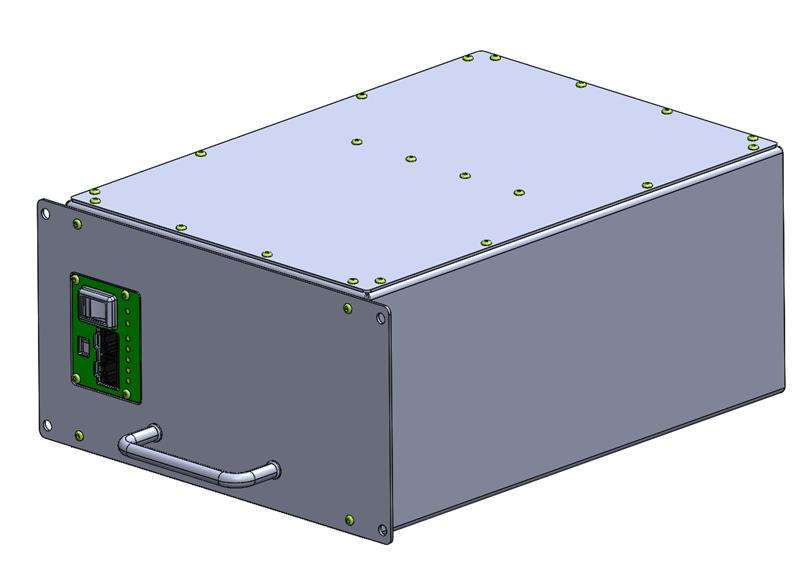

Material Safety
Data Sheet
LiFePO4 battery pack 1.2kWh
24V 50Ah
under the Official Information Act 1982
VAULTA
Released

MSDS, LiFePO4 Battery Pack
Safety Sheet Series
OVERVIEW
Vaulta has provided accurate information here; however, the user should ultimately determine the final
compatibility of the materials. It's important to note that all materials in battery technology are assumed to be
hazardous, requiring a significant degree of caution. Classification is adapted from GHS.
Section 1.
COMPANY AND PRODUCT IDENTIFICATION
1982
Product identifier
1.2kWh Lithium Iron Phosphate (LFP) Battery Pack
Manufacturer’s Name
Vaulta
Act
Manufacturer’s Address
53 Holland Street, ARM Hub, Northgate, QLD 4013
Email
[email address]
Website
https://www.vaulta.com.au
Section 2.
HAZARDS IDENTIFICATION
Emergency Overview
The product is a battery containing chemical substances. It should not be
exposed to fire, exceeded mechanical shocks, misused electrical stress and
Information
chemicals.
Primary Route(s) of Exposure
Eye, skin contact, ingestion, inhalation
Signal Word
Warning
Storage
P403: Store in a well-ventilated place + P235: Keep cool.
Hazard statements
Health Hazard if not used according to instructions of manufacturer. In
Official
that case:
H315: Causes Skin Irritation
H319: Causes Serious Eye Irritation
H355: May Cause Respiratory Irritation
the
Prevention
P264: Wash Skin and Clothing Thoroughly After Handling
P261: Avoid Breathing Dust, Fume, Gas, Mist, Vapours, Spray
(in the case of failure incident)
Response
P314: Get Medical Advice/Attention If You Feel Unwell
P302+P353: If ON SKIN, Wash with Plenty of Water
P304+P340: If INHALED, Remove Person to Fresh Air and Keep
under Comfortable for Breathing
P305+P351+P338: If IN EYES, Rinse Cautiously with Water to Several
Minutes. Remove Contact Lenses, if Present and Easy to Do. Continue
Rinsing
Disposal
P501: Dispose of Contents to Approved Waste Treatment Plants
Released
Page 1 of 7
Issue date: 14/04/2025. Version 1.1

MSDS, LiFePO4 Battery Pack
Safety Sheet Series
Section 3.
COMPOSITION/INFORMATION ON INGREDIENTS
Chemical
Chemical Composition
Weight(%) CAS No.
EC No.
Formula
Lithium Iron Phosphate
LiFePO4
34.1
15365-14-7
921-62-3
Electrolyte (proprietary)
LiPF6/EC+DEC
20.3
/
/
1982
Aluminum foil
Al
3.5
7429-90-5
213-0072-3
Carbon (proprietary)
C
16.5
7782-42-5
231-955-3
Copper foil
Cu
7.8
7440-50-8
213-159-6
Act
Separator (proprietary)
(C3H6)n
3
9003-07-0
/
Aluminium Alloy
Al
14.6
7429-90-5
213-0072-3
SUM
100
Section 4.
FIRST AID MEASURES
General Advice
Immediate medical attention is required. Show this document (MSDS) to the doctor
Information
in attendance.
Eye Contact
Rinse thoroughly with plenty of water for at least 15 minutes, occasionally lifting and
lower eyelids and consult a physician if feel uncomfortable
Skin
Remove contaminated clothes and rinse skin with plenty of water or shower for 15
minutes. Get medical aid.
Inhalation
Remove from exposure and move to fresh air immediately. Use oxygen if available.
Official
Ingestion
Give at least 2 glasses of milk or water. Induce vomiting unless patient is unconscious.
Call a physician.
the
Section 5.
FIRE-FIGHTING MEASURES
Flash Point
N/A.
Auto-Ignition Temperature
N/A.
under
Extinguishing media
CO2, dry chemical powder, wet sand, plenty of water (for cooling)
Special Fire-Fighting Procedures
Self-contained breathing apparatus
Unusual Fire and Explosion Battery may burst and release hazardous decomposition products when
exposed to a fire situation. Lithium batteries contain flammable
Hazards
ingredients that may vent, ignite and produce sparks when subjected to
high temperature (>150℃), When damaged or abused (e.g. mechanical
damage or electrical overcharging); may burn rapidly with flare-burning
effect; may ignite other batteries in close proximity.
Released
Hazardous Combustion Products
Carbon monoxide, carbon dioxide, lithium oxide fumes
Page 2 of 7
Issue date: 14/04/2025. Version 1.1

MSDS, LiFePO4 Battery Pack
Safety Sheet Series
Section 6.
ACCIDENTAL RELEASE MEASURES
Steps to be taken in case material is released or spilled
If the battery material is released, remove personnel from area until fumes dissipate. Provide maximum
ventilation to clear out hazardous gases. Wipe it up with a cloth and dispose of it in aplastic bag and put into
a steel can. The preferred response is to leave the area and allow the battery to cool and vapours to dissipate.
Provide maximum ventilation. Avoid skin and eye contact or inhalation of vapours. Remove spilled liquid 1982
with absorbent and incinerate.
Waste Disposal Method
It is recommended to discharge the battery to the end, handing in the abandoned batteries to related department
Act
unified, dispose of the batteries in accordance with approved local, state, and federal requirements.
Section 7.
HANDLING AND STORAGE
The battery should not be opened, destroyed or incinerate, since they may leak or rupture and release to the
environment the ingredients that they contain in the hermetically sealed container. Do not short circuit
terminals, or over charge the battery, forced over-discharge, throw to fire. Do not crush or puncture the battery
Information
or immerse in liquids. Store batteries in a dry place at normal room temperature.
Precautions to be taken in handling and storing
Avoid mechanical or electrical abuse. Storage preferably in cool, dry and ventilated area, which is subject
to little temperature change. Storage at high temperatures should be avoided. Do not place the battery near
heating equipment, nor expose to direct sunlight for long periods.
Official
Other Precautions
The battery may explode or cause burns, if disassembled, crushed or exposed to fire or high temperatures.
the
Do not short or install with incorrect polarity.
under
Released
Page 3 of 7
Issue date: 14/04/2025. Version 1.1

MSDS, LiFePO4 Battery Pack
Safety Sheet Series
Section 8.
EXPOSURE CONTROLS/PERSONAL PROTECTION
Respiratory Protection
In case of battery venting, provide as much ventilation as possible.
Avoid confined areas with venting cell cores.
Respiratory protection is not necessary under conditions of normal use.
1982
Ventilation
Not necessary under conditions of normal use.
Personal Protection is recommended for venting battery
Act
Respiratory Protection, Protective Gloves, Protective Clothing and safety glass with side shields.
Protective Gloves
Not necessary under conditions of normal use. Use butyl rubber gloves when handling leaking batteries. Wear
safety goggles when handling leaking batteries.
Other Protective Clothing or Equipment
Not necessary under conditions of normal use.
Information
Section 9.
PHYSICAL AND CHEMICAL PROPERTIES
Appearance
Prismatic shape cells in the pack.
Odour
No odour
pH
Not applicable
Official
Melting Point/freezing point
Not applicable
Initial boiling point and Boiling range
Not applicable
the
Flash Point
Not applicable
Evaporation rate
Not applicable
Flammability (solid, gas)
Not applicable
Upper/lower flammability or explosive limits
Not applicable
under
Vapor Pressure
Not applicable
Vapor Density
Not applicable
Relative density
Not applicable
Solubility (water)
Insoluble
n-octanol/water partition coefficient
Not applicable
Auto-ignition temperature
Product is not self-igniting
Released
Decomposition temperature
Not applicable
Page 4 of 7
Issue date: 14/04/2025. Version 1.1

MSDS, LiFePO4 Battery Pack
Safety Sheet Series
Section 10.
STABILITY AND REACTIVITY
Stability
Product is stable under conditions described in Section 7
Conditions to avoid
Heat above 70°C or incinerate. Deformation. Mutilate. Crush.
Disassemble. Overcharge. Short circuit. Expose over a long 1982
period to humid conditions.
Materials to avoid
Oxidising agents, Strong acids
Hazardous Decomposition Products
Carbon oxides, other irritating and toxic gases
Act
Hazardous Polymerization
N/A
If leaked, forbidden to contact with strong oxidizers, mineral acids, strong alkali, halogenated hydrocarbons
Section 11.
TOXICOLOGICAL INFORMATION
Signs & symptoms
None, unless battery ruptures
Respiratory or skin sensitization
No sensitizing effects known
Information
Skin contact
No irritant effect
Eye contact
Cause serious eye irritation
Specific target organ system toxicity
No information available
In the event of exposure to internal contents, vapour fumes may be very irritating to the eyes and skin.
Irritation to the internal/external mouth areas, may occur following exposure to a leaking battery. Seek
Official
immediate medical advice.
Medical conditions generally aggravated by exposure: In the event of exposure to internal contents, moderate
the
to server irritation, burning and dryness of the skin may occur, target organs nerves, liver and kidneys.
Section 12.
ECOLOGICAL INFORMATION
under
Toxicity
No further relevant information available
Persistence and degradability
No further relevant information available
Bioaccumulative potential
No further relevant information available
Mobility in soil
No further relevant information available
Results of PBT and vPvB assessment
PBT: Not applicable. vPvB: Not applicable
Other adverse effects
No information available
Released
Page 5 of 7
Issue date: 14/04/2025. Version 1.1

MSDS, LiFePO4 Battery Pack
Safety Sheet Series
Section 13.
DISPOSAL CONSIDERATION
Do not incinerate, or subject cells to temperature in excess of 70°C, such abuse can result in loss of seal
leakage, and/or cell explosion.
If batteries are still fully charged or only partially discharged, they can be considered a reactive hazardous
waste because of significant amount of not reaction or unconsumed lithium remaining in the spent battery. 1982
The battery must be neutralized through an approved secondary treatment facility prior to disposal as a
hazardous waste. Recycling of battery can be done in authorized facility, through licensed
Act
Section 14.
TRANSPORT INFORMATION
Transport hazard class
Class 9—Lithium Battery hazard label, the Cargo aircraft Only Label, the
shipping mark (assigned for cells not the pack)
UN Number
No assigned.
Packing Group
NA
Marine pollutant
No
UN Proper Shipping name
Lithium ion batteries
Information
The lithium-ion cells used in this battery pack have been tested and certified according to the requirements of
the UN Manual of Tests and Criteria, Part III, Subsection 38.3.
The cells are classified as UN3480, Class 9, Packaging Group II, and comply with IMDG Code Amdt. 41-22,
Packing Instruction P903.
The State of Charge (SOC) must not exceed 30–35% during transport (as per UN and IATA recommendations
Official
for prototype batteries).
The pack should be transported in robust, short-circuit-protected packaging with clearly visible.
the
Avoid air transport unless operating under IATA Special Provision A88 or A99, which allows transport of non-
certified batteries with prior approval.
Battery packs should be packed in strong outer packaging to prevent short-circuiting, drops, or mechanical
damage during transport.
under
Released
Page 6 of 7
Issue date: 14/04/2025. Version 1.1


MSDS, LiFePO4 Battery Pack
Safety Sheet Series
Section 15.
REGULATION INFORMATION
Safety, health, and environmental regulations
The lithium-ion cells used in this battery pack comply with the following international and national
regulations:
Globally Harmonized System of Classification and Labelling of Chemicals (GHS)
1982
Recommendations on the TRANSPORT OF DANGEROUS GOODS Model Regulations
IATA Dangerous Goods Regulations(DGR)
International Maritime Dangerous Goods Code(IMDG CODE)
Act
EU Regulation:
Regulation (EU) 2020/878: Revised Requirements for EU Safety Data Sheets
EU regulation (EC) 1272/2008 on "Classification, Labeling and Packaging of Substances and Mixtures"
(CLP)
Registration,Evaluation and Authorization of Chemicals(REACH)
Agreement concerning the International Carriage of Dangerous Goods by Road (ADR)
US Regulation:
Information
American National Standard for Hazardous Workplace Chemicals – Hazard Evaluation and Safety Data Sheet
and Precautionary Labeling Preparation
US DOT, Code of Federal Regulations, Title 49, Transportation, PT. 100-185
Official
Section 16.
OTHER INFORMATION
This file is only effective to the batteries provided by Vaulta. The commissioner provides the composition
the
information of batteries and promises its integrity and accuracy.
Users should read this file carefully and use the batteries in correct method. Vaulta doesn’t assume
responsibility for any damage or loss because of misuse of batteries.
Sample photo: under
Released
Page 7 of 7
Issue date: 14/04/2025. Version 1.1









